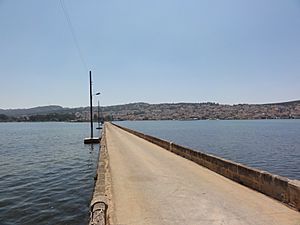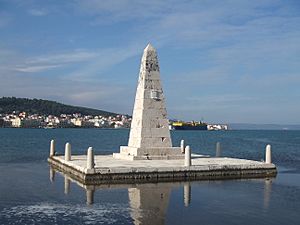De Bosset Bridge facts for kids
Quick facts for kids De Bosset BridgeΓέφυρα Ντε Μποσέ |
|
|---|---|

De Bosset Bridge shortly before restoration
|
|
| Coordinates | 38°10′30″N 20°29′45″E / 38.17500°N 20.49583°E |
| Carries | Pedestrian (footbridge) |
| Locale | Argostoli, Cephalonia, Greece |
| Characteristics | |
| Material | Stone |
| Total length | 689.9 metres (2,263 ft) |
| History | |
| Construction end | 1813 |
The De Bosset Bridge is a super cool stone bridge in Kefalonia, Greece. It was built way back in 1813 across the bay of Argostoli. This amazing bridge is about 690 meters long. That makes it the longest stone bridge in the whole world that crosses ocean water! It used to be called the Drapano Bridge.
Contents
The Bridge's Story
Long ago, the Republic of the Ionian Islands was looked after by the British. As part of their rule, the British helped build important things like roads and bridges. This was a way to improve the islands.
In 1810, a Swiss engineer named Charles de Bosset became the governor of Kefalonia. He really cared about building good roads and bridges. He helped create many shorter routes by building bridges over tricky areas.
His biggest project was the bridge over the Argostoli Bay. It was meant to connect Argostoli to Drapano. This new bridge would make the trip to Lixouri and the northern part of the island much shorter. It also separates the Koutavos lagoon from the main bay.
Getting the Bridge Built
In 1812, De Bosset shared his idea for the bridge with the island council. They needed to approve the construction. Some people worried that the bridge might make it easier for robbers to escape. This was because the northern end of the bridge was (and still is) a quiet, unpopulated area.
During a meeting, De Bosset was very determined. He reportedly hit a sword on the table! He said he could handle small concerns if needed. This showed how much he wanted the bridge to be built.
Building and Changes
The bridge was first built using wood. But soon after, it was slowly replaced, piece by piece, with strong sandstone. The bridge's surface rests on 16 low stone arches. One of these arches is actually filled in.
There's a small island made by people along the bridge. On this island, you can see an obelisk. This monument was put there by the British.
In 1953, a big earthquake hit the Ionian Islands. Parts of the bridge collapsed. Even after repairs, you can still see the damage from the side today. In 1970, the bridge was officially recognized as a historical monument.
Modern Times and Renovation
The bridge ends right in the middle of Argostoli. Over time, this became a problem for city traffic. So, in 2009, the bridge was closed to heavy vehicles. Later, it was closed to all cars.
Experts checked the bridge's safety in 2005. They suggested replacing some concrete fillings with sandstone. From 2011 to 2013, the bridge got a big makeover! It was reopened as a bridge just for people walking.
During this restoration, the concrete from 1953 was removed. It was replaced with the original sandstone. The old asphalt was taken off and replaced with paving stones. Even the old light poles in the sea were replaced with new ones that looked just like the originals.


